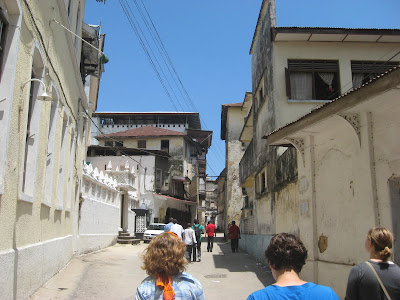Yesterday the wanafunzi wa ACM moved out of Hall 3 and into the homes of our host families. We had the opportunity to meet them on Friday, but it didn’t quite prepare me for the experience of moving in. Before the move, we got a little talk about living in a Tanzanian home from Paulina, Dr. Roberts’ assistant at UDSM. It’s like being a teenager all over again – we’re expected to divulge our whereabouts when we come and go, no shoes in the house, and no drinking alcohol in front of parents! *gasp*
But I’m not complaining. Mama Kwame’s flat is a delightful change from our beloved yet grungy Hall 3 – and the grub is top-notch. Paulina predicted that many of us would be served pilau (spiced rice, usually with meat) on arriving, as it is a standard meal prepared for guests by many Tanzanians with origins in the Kilimanjaro region of the country. Mama Kwame’s pilau is the best I’ve had so far, and there was plenty of it. She migrated to the couch to watch a prime-time Tanzanian soap opera during dinner, but if anything started to run low, a rapid order in Swahili would summon more to the table. She has eyes like a hawk, and is apparently “breaking in” a new maid. Many of the university faculty and staff live comfortably enough to employ some help around the house. In some cases, like ours, that help is a young girl who is treated kind of like an additional family member. I don’t much about the system, but I’ll undoubtedly learn more.
The homestay will definitely help my shoddy Swahili, though it can be a little embarrassing to hack through a sentence with the knowledge that my hosts all speak perfect English – my host brother speaks great English with a quasi-American accent (with the occasional bits of British vocabulary), which is going to trip me up for a while. However, they’re more than willing to help me learn. I’m going to learn lots more, too: there’s a Swahili proverb about taking great care of a guest for two days, but on the third, you put him to work!






















